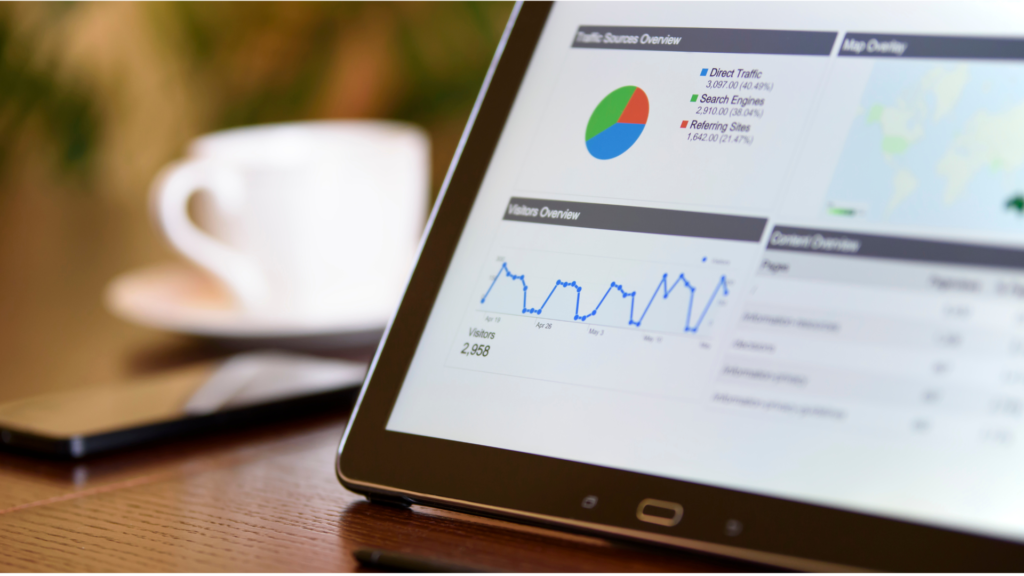Learning how to measure website traffic can help you evaluate the success or failure of your online presence. Whether you’re an experienced webmaster or a beginner just starting to explore SEO and analytics, this guide by Zircon SEO will give you the technical know-how to track visitor engagement accurately.
Our comprehensive overview walks through factors like sources of traffic, referral channels, average time on page, bounce rate – and more. We look forward to equipping you with knowledge for gathering actionable data that can improve your digital marketing strategy.
What Is Website Traffic Analytics?

Website traffic analytics refers to collecting, analyzing, and interpreting data related to user interactions on a website. It involves tracking metrics like the number of visitors, page views, bounce rates, referral sources, and user behaviors. This data provides valuable insights into the effectiveness of a website, user engagement, and overall performance.
Key Metrics To Measure Traffic
Conversions And Engagement Events
Measuring the number of conversions and engagement events, such as form submissions, downloads, or purchases, indicates the effectiveness of your website in driving desired user actions. Tracking these metrics provides insight into user intent and the success of your call-to-actions.
Landing Pages
Monitoring the performance of individual landing pages helps identify which ones attract the most traffic and encourage engagement. This data enables you to optimize these pages for even better user experiences and conversion rates.
Channels
Analyzing traffic sources (social media, direct visits, organic search traffic) enables you to understand where your visitors are coming from. This information helps allocate resources effectively and tailor your marketing strategies to the most productive channels.
Visitors And Users
Distinguishing between the total number of visitors and the number of unique visitors helps understand the size of your audience. While visitors represent overall traffic from search engines, users indicate unique individuals interacting with your site, offering insights into your site’s reach and appeal.
Bounce Rate
Bounce rate measures the percentage of visitors who leave your site after viewing only one page. A high bounce rate suggests a mismatch between user expectations and your content, highlighting the need for improvements to keep visitors engaged and exploring.
Page Views Per Session
This metric indicates how much content users consume during a single visit. Higher page views per session demonstrate user interest and engagement, reflecting effective navigation and appealing content.
Average Session Duration
Average session duration reveals the amount of time users spend on your site. Longer durations indicate that visitors find your content valuable and engaging. This metric can also help identify areas where users are spending more time.
Devices
Understanding the devices your visitors use (desktop, mobile, tablet) is essential for optimizing user experience. Responsive design and mobile optimization ensure your site caters to all device types, contributing to lower bounce rates and higher engagement.
List Of Tools To Check Any Website Traffic
Semrush: Comprehensive SEO tool offering traffic insights, keyword analysis, and competitive research.
Similarweb: Provides traffic data, audience insights, and competitor analysis for websites.
Google Search Console: Google’s tool for monitoring search performance, indexing, and site health.
Ubersuggest: Offers keyword research, traffic analysis, and content suggestions.
Serpstat: All-in-one SEO platform with competitor analysis, keyword research, and backlink tracking.
Ahrefs: Powerful SEO suite with traffic analysis, backlink research, and keyword tracking.
Monsterinsights: WordPress plugin connecting your site to Google Analytics for detailed traffic insights.
Reasons You Should Check Your Website Traffic

Performance Evaluation
Regularly checking your traffic statistics allows you to assess its overall performance. Monitoring metrics like pageviews, sessions, and engagement rates gives you insight into how well your site is attracting and retaining visitors.
User Behavior Insights
Analyzing web traffic data provides valuable insights into user behavior. You can understand which pages are most visited, how users navigate your site, and what content they find most engaging.
Content Effectiveness
A Website’s traffic data gauges the effectiveness of your content. By tracking metrics like time spent on pages, bounce rates, and conversion rates, you can identify which content resonates with your audience and which might need improvement.
Goal Tracking
Checking website traffic is essential for tracking your goals. Whether it’s lead generation, e-commerce sales, or subscriptions, understanding the correlation between traffic and goal completions helps refine your strategies.
Conversion Analysis
Website traffic analysis provides insights into your conversion funnel. You can identify where users drop off and make necessary adjustments to improve the conversion rate.
Marketing ROI
By understanding which marketing channels drive traffic, you can assess your marketing efforts’ return on investment (ROI). This information helps allocate resources to the most effective strategies.
User Experience Enhancement:
Monitoring website traffic helps you uncover user experience issues. High bounce rates, short session durations, or low engagement can indicate areas where your site needs improvement to keep visitors engaged and satisfied.
Why Measure Your Competitor’s Website Traffic?
Benchmarking And Comparison
Analyzing competitor traffic helps you benchmark your own website’s performance. By comparing metrics like visitors, engagement rates, and conversion rates, you gain a clear understanding of where you stand in relation to your competitors.
Identifying Market Trends
Studying your competitors’ traffic patterns can reveal market trends and shifts in user behavior. Understanding what attracts their audience and drives traffic to their site can help you align your strategies to capitalize on these trends.
Uncovering Opportunities
Analyzing competitor traffic can uncover gaps and opportunities in the market that you have missed. Identifying underserved areas allows you to tailor your offerings and content to meet the needs of the target audience.
Evaluating Success Factors
Analyzing competitor traffic helps you understand what contributes to their success. Whether it’s effective social media campaigns, referral traffic, or partnerships, you can learn from their strategies and adapt them to your advantage.
Adapting And Innovating
Keeping an eye on competitor traffic helps you stay agile and adaptable. If you notice shifts in their tactics leading to increased traffic, you can adjust your strategies to stay competitive and relevant in the ever-changing digital landscape.
SEO Insights
Studying competitor website traffic can provide insights into their search engine optimization (SEO) strategies. Understanding which keywords drive traffic to their site can help you refine your keyword targeting and content optimization efforts.
Using Website Traffic Data To Improve Performance
Identifying Weak Points In The User Journey
Website traffic data helps pinpoint areas where users drop off or encounter obstacles. Analyzing bounce rates, exit pages, and behavior flows reveals pain points. This insight enables targeted improvements to enhance user experience and encourage desired actions, increasing conversions.
Optimizing Landing Pages
You can identify successful design and content elements by studying which landing pages attract the most traffic and the highest engagement. Apply these insights to other landing pages, refining their structure, visuals, and messaging for better user engagement and conversion rates.
Refining Content Strategy
Website traffic analytics reveal which content resonates with visitors. Analyze page views, time spent, and social shares to determine popular topics. Tailor your content strategy to create more of what your audience values, enhancing user engagement and increasing the likelihood of repeat visits and conversions.
Adapting Marketing Campaigns
Traffic data allows you to evaluate the effectiveness of various marketing channels and campaigns. By comparing the performance of different traffic sources, you can allocate resources to the most successful channels and refine underperforming campaigns, ensuring your marketing efforts yield the best possible results.
Conclusion

Every business is unique, and so are its goals. That is why it is important to customize the strategies that best suit your needs. By utilizing accurate metrics and analytics, you can track user interactions on your website and discover areas for improvement. With the right SEO strategies tailored for you by Zircon SEO, success is just waiting to be found.
Whether you’re starting from scratch or revamping existing digital assets, our team of SEO specialists can get you the results you need to triumph in today’s digital landscape. Why not join us on this exciting journey?
FAQs
How To Look For Reports In GA4?
In Google Analytics 4 (GA4), accessing reports is straightforward. After logging in, navigate to your property, and click on "Reports" on the left sidebar. Here, you'll find a range of predefined reports like "Life Cycle Reports" and "Events," providing insights into user behavior, conversions, and more. Customizing and drilling down into data is easily achieved through the intuitive interface.
How Does Google Analytics 4 Measure Website Traffic?
Google Analytics 4 measures website traffic using an event-based model. It focuses on "events," tracking specific user interactions like pageviews, clicks, and conversions. These events are collected using the global site tag and are organized into various categories, allowing you to analyze user engagement and behaviors more comprehensively compared to traditional pageview-based metrics.
How Do Website Traffic Checkers Work?
Website traffic checkers, also known as analytics tools, collect website data about visitors and their actions. They use tracking codes and cookies to monitor user interactions, analyzing factors like pageviews, bounce rates, and referral sources. This data helps website owners understand user behavior, optimize content, and make informed decisions to enhance user experience and engagement.
How To Calculate Traffic Goals To Increase Website Revenue
To calculate traffic goals for revenue growth, start by identifying your current conversion rate (conversions divided by total visits). Determine your desired revenue increase and divide it by your average transaction value. This gives you the number of additional conversions needed. Calculate the corresponding increase in traffic by dividing this number by your website's average conversion rate.

